buttons HUMMER H2 2004 User Guide
[x] Cancel search | Manufacturer: HUMMER, Model Year: 2004, Model line: H2, Model: HUMMER H2 2004Pages: 472, PDF Size: 5.01 MB
Page 126 of 472
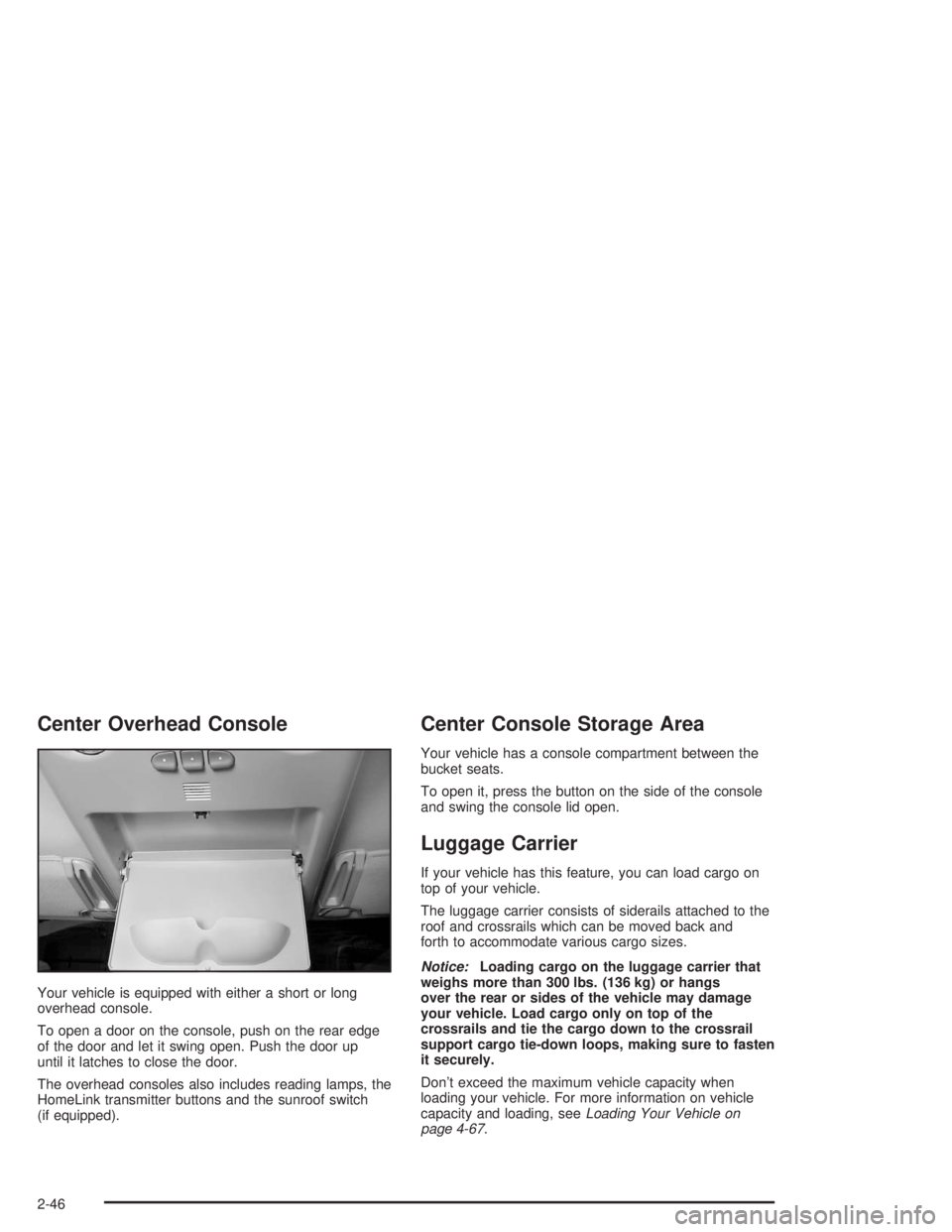
Center Overhead Console
Your vehicle is equipped with either a short or long
overhead console.
To open a door on the console, push on the rear edge
of the door and let it swing open. Push the door up
until it latches to close the door.
The overhead consoles also includes reading lamps, the
HomeLink transmitter buttons and the sunroof switch
(if equipped).
Center Console Storage Area
Your vehicle has a console compartment between the
bucket seats.
To open it, press the button on the side of the console
and swing the console lid open.
Luggage Carrier
If your vehicle has this feature, you can load cargo on
top of your vehicle.
The luggage carrier consists of siderails attached to the
roof and crossrails which can be moved back and
forth to accommodate various cargo sizes.
Notice:Loading cargo on the luggage carrier that
weighs more than 300 lbs. (136 kg) or hangs
over the rear or sides of the vehicle may damage
your vehicle. Load cargo only on top of the
crossrails and tie the cargo down to the crossrail
support cargo tie-down loops, making sure to fasten
it securely.
Don’t exceed the maximum vehicle capacity when
loading your vehicle. For more information on vehicle
capacity and loading, seeLoading Your Vehicle on
page 4-67.
2-46
Page 131 of 472

Vent:The vent position allows you to open the rear
of the sunroof by tilting it upward. To use the vent
position, start with the sunroof in the fully closed
position, then press and hold the front side of the
switch until the sunroof reaches the desired
vent position or until it stops moving. To close the
sunroof from the vent position, press and hold
the rear side of the switch until the sunroof is fully
closed.
Do not to leave the sunroof open for long periods of
time as debris may collect in the tracks.
Sunshade Operation
The sunshade will open automatically when opening the
sunroof.
To adjust the sunshade, pull it backward or forward to
the desired position. The sunshade can not be
closed further than the current closed position of the
sunroof.
Although the sunshade opens automatically when
opening the sunroof, it must be manually pulled closed
after closing the sunroof.
Vehicle Personalization
Memory Seat
If your vehicle has this
feature, the controls for the
memory function are
located on the driver’s door.
These buttons are used to program and recall memory
settings for the driver’s seat, both the driver’s and
passenger’s outside mirror, the radio station presets,
and the previously used climate control system settings.
The settings for these features can be personalized
for both driver 1 and driver 2. Driver 1 or driver 2
corresponds to the memory buttons labeled 1 and 2 on
the driver’s door and the numbers on the back of
the remote keyless entry transmitters.
2-51
Page 132 of 472
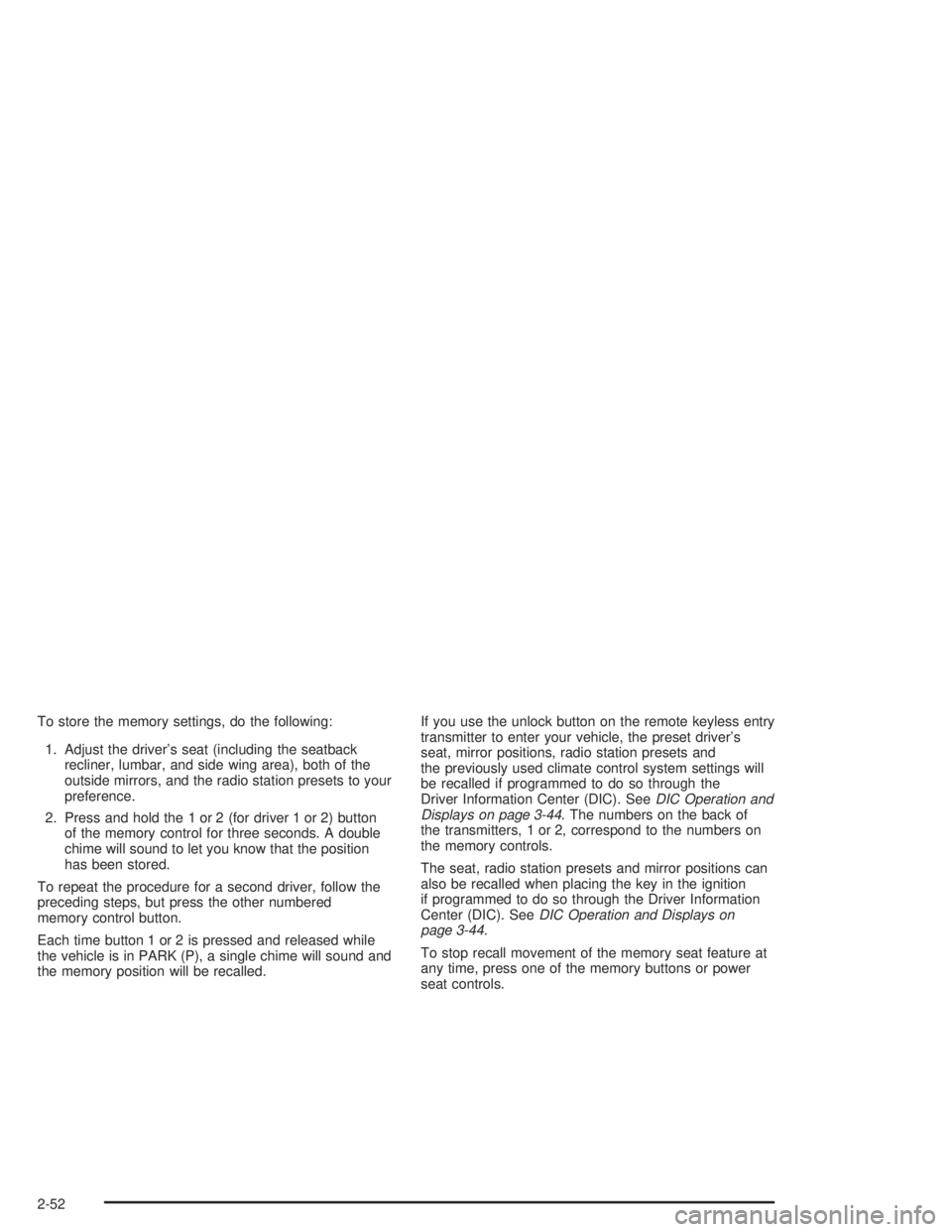
To store the memory settings, do the following:
1. Adjust the driver’s seat (including the seatback
recliner, lumbar, and side wing area), both of the
outside mirrors, and the radio station presets to your
preference.
2. Press and hold the 1 or 2 (for driver 1 or 2) button
of the memory control for three seconds. A double
chime will sound to let you know that the position
has been stored.
To repeat the procedure for a second driver, follow the
preceding steps, but press the other numbered
memory control button.
Each time button 1 or 2 is pressed and released while
the vehicle is in PARK (P), a single chime will sound and
the memory position will be recalled.If you use the unlock button on the remote keyless entry
transmitter to enter your vehicle, the preset driver’s
seat, mirror positions, radio station presets and
the previously used climate control system settings will
be recalled if programmed to do so through the
Driver Information Center (DIC). SeeDIC Operation and
Displays on page 3-44. The numbers on the back of
the transmitters, 1 or 2, correspond to the numbers on
the memory controls.
The seat, radio station presets and mirror positions can
also be recalled when placing the key in the ignition
if programmed to do so through the Driver Information
Center (DIC). SeeDIC Operation and Displays on
page 3-44.
To stop recall movement of the memory seat feature at
any time, press one of the memory buttons or power
seat controls.
2-52
Page 137 of 472
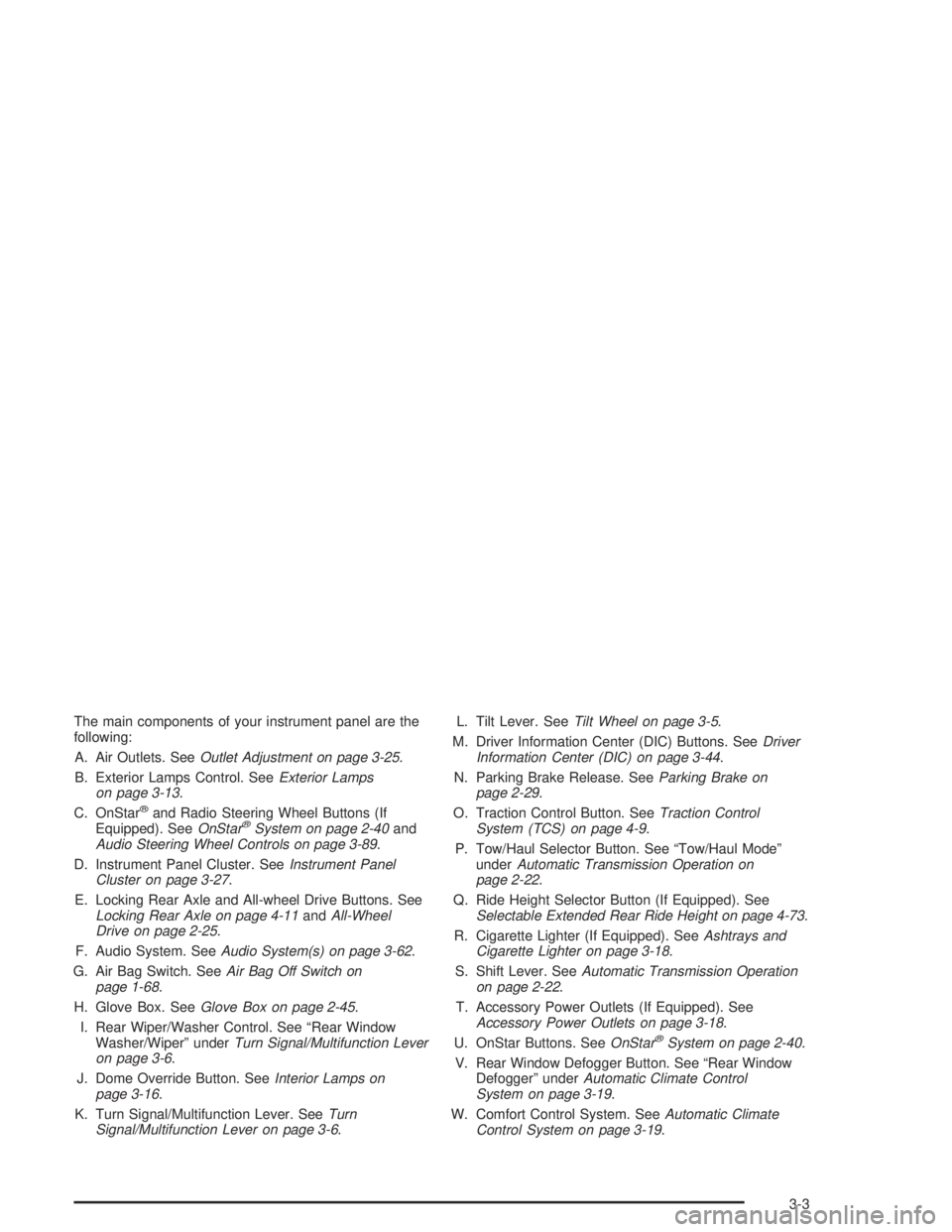
The main components of your instrument panel are the
following:
A. Air Outlets. SeeOutlet Adjustment on page 3-25.
B. Exterior Lamps Control. SeeExterior Lamps
on page 3-13.
C. OnStar
®and Radio Steering Wheel Buttons (If
Equipped). SeeOnStar®System on page 2-40and
Audio Steering Wheel Controls on page 3-89.
D. Instrument Panel Cluster. SeeInstrument Panel
Cluster on page 3-27.
E. Locking Rear Axle and All-wheel Drive Buttons. See
Locking Rear Axle on page 4-11andAll-Wheel
Drive on page 2-25.
F. Audio System. SeeAudio System(s) on page 3-62.
G. Air Bag Switch. SeeAir Bag Off Switch on
page 1-68.
H. Glove Box. SeeGlove Box on page 2-45.
I. Rear Wiper/Washer Control. See “Rear Window
Washer/Wiper” underTurn Signal/Multifunction Lever
on page 3-6.
J. Dome Override Button. SeeInterior Lamps on
page 3-16.
K. Turn Signal/Multifunction Lever. SeeTurn
Signal/Multifunction Lever on page 3-6.L. Tilt Lever. SeeTilt Wheel on page 3-5.
M. Driver Information Center (DIC) Buttons. SeeDriver
Information Center (DIC) on page 3-44.
N. Parking Brake Release. SeeParking Brake on
page 2-29.
O. Traction Control Button. SeeTraction Control
System (TCS) on page 4-9.
P. Tow/Haul Selector Button. See “Tow/Haul Mode”
underAutomatic Transmission Operation on
page 2-22.
Q. Ride Height Selector Button (If Equipped). See
Selectable Extended Rear Ride Height on page 4-73.
R. Cigarette Lighter (If Equipped). SeeAshtrays and
Cigarette Lighter on page 3-18.
S. Shift Lever. SeeAutomatic Transmission Operation
on page 2-22.
T. Accessory Power Outlets (If Equipped). See
Accessory Power Outlets on page 3-18.
U. OnStar Buttons. SeeOnStar
®System on page 2-40.
V. Rear Window Defogger Button. See “Rear Window
Defogger” underAutomatic Climate Control
System on page 3-19.
W. Comfort Control System. SeeAutomatic Climate
Control System on page 3-19.
3-3
Page 152 of 472
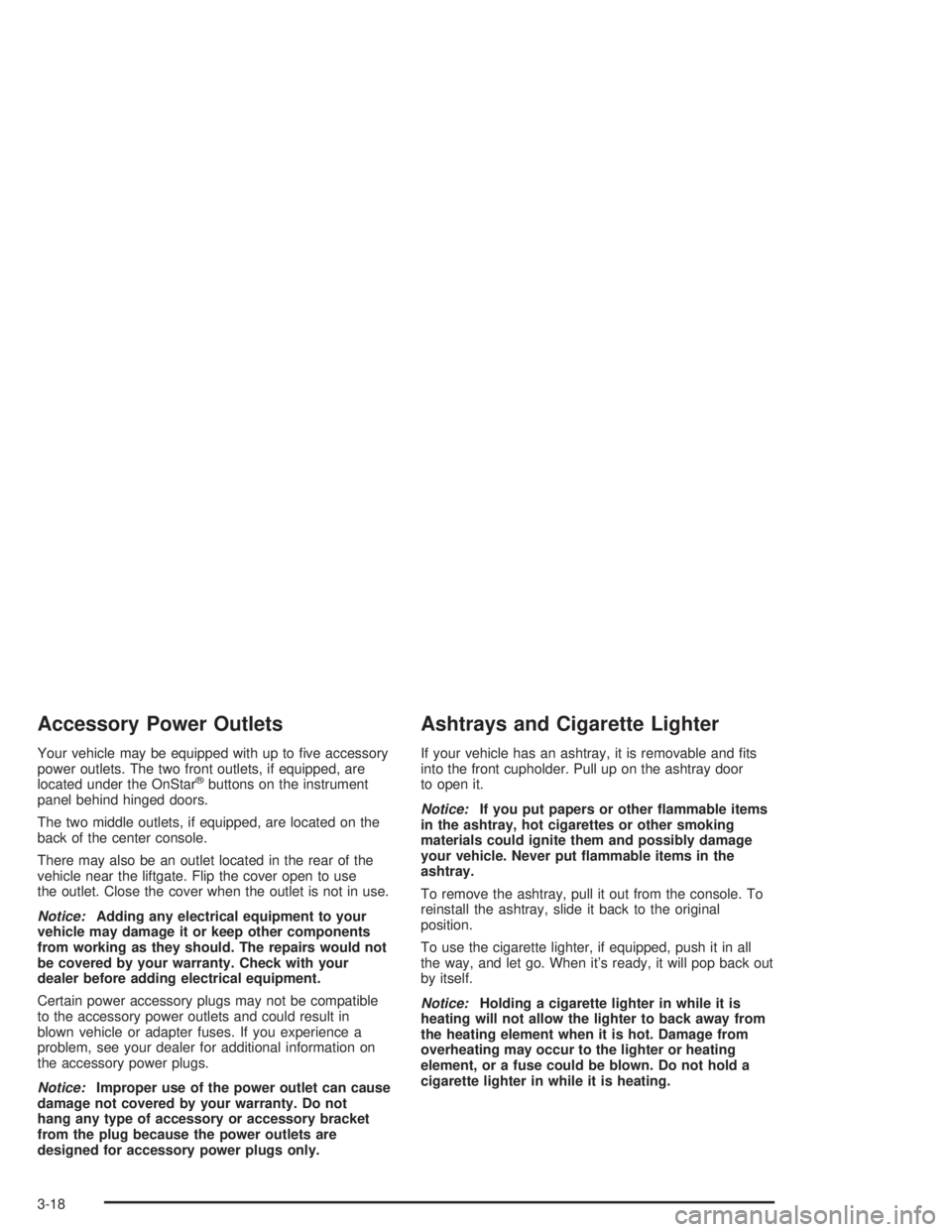
Accessory Power Outlets
Your vehicle may be equipped with up to �ve accessory
power outlets. The two front outlets, if equipped, are
located under the OnStar
®buttons on the instrument
panel behind hinged doors.
The two middle outlets, if equipped, are located on the
back of the center console.
There may also be an outlet located in the rear of the
vehicle near the liftgate. Flip the cover open to use
the outlet. Close the cover when the outlet is not in use.
Notice:Adding any electrical equipment to your
vehicle may damage it or keep other components
from working as they should. The repairs would not
be covered by your warranty. Check with your
dealer before adding electrical equipment.
Certain power accessory plugs may not be compatible
to the accessory power outlets and could result in
blown vehicle or adapter fuses. If you experience a
problem, see your dealer for additional information on
the accessory power plugs.
Notice:Improper use of the power outlet can cause
damage not covered by your warranty. Do not
hang any type of accessory or accessory bracket
from the plug because the power outlets are
designed for accessory power plugs only.
Ashtrays and Cigarette Lighter
If your vehicle has an ashtray, it is removable and �ts
into the front cupholder. Pull up on the ashtray door
to open it.
Notice:If you put papers or other �ammable items
in the ashtray, hot cigarettes or other smoking
materials could ignite them and possibly damage
your vehicle. Never put �ammable items in the
ashtray.
To remove the ashtray, pull it out from the console. To
reinstall the ashtray, slide it back to the original
position.
To use the cigarette lighter, if equipped, push it in all
the way, and let go. When it’s ready, it will pop back out
by itself.
Notice:Holding a cigarette lighter in while it is
heating will not allow the lighter to back away from
the heating element when it is hot. Damage from
overheating may occur to the lighter or heating
element, or a fuse could be blown. Do not hold a
cigarette lighter in while it is heating.
3-18
Page 159 of 472
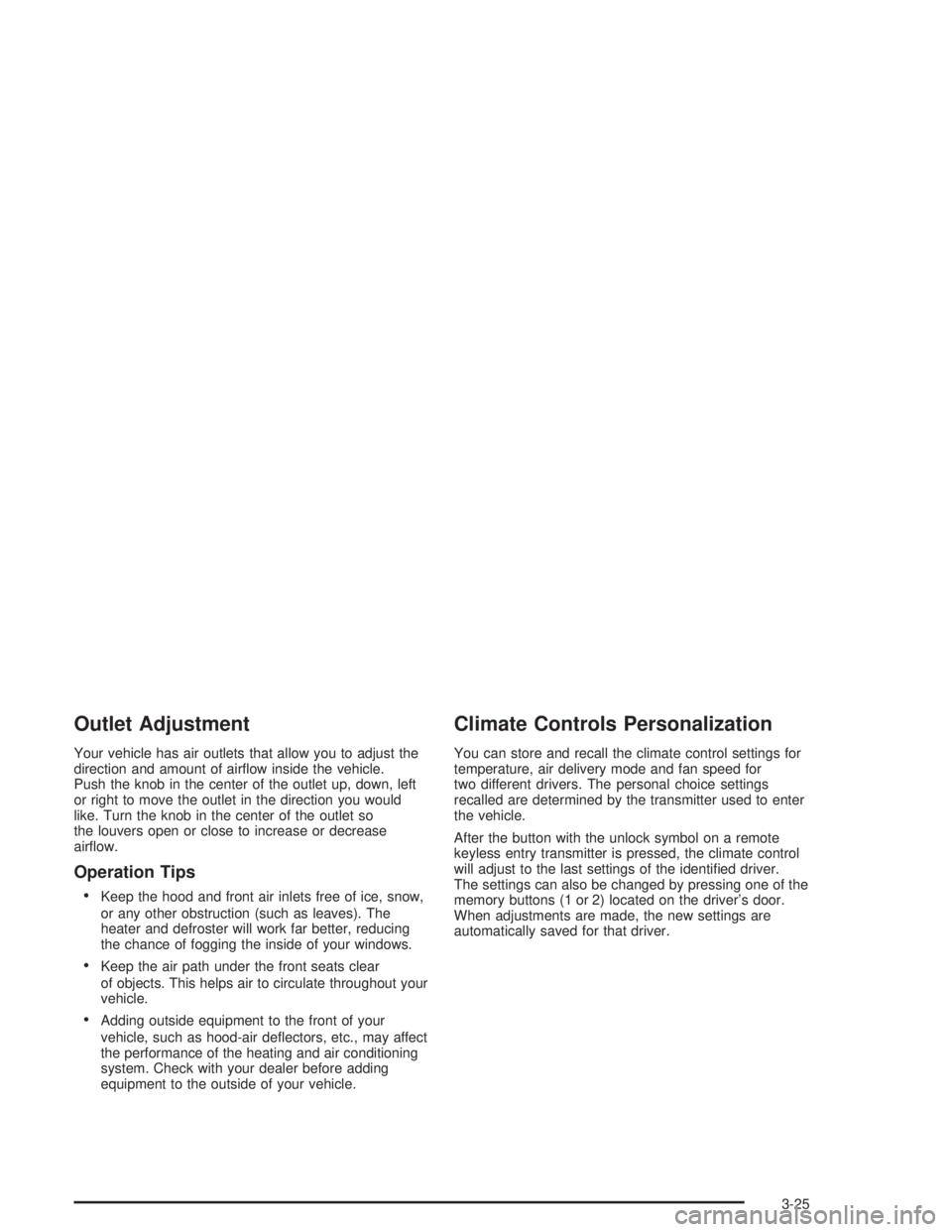
Outlet Adjustment
Your vehicle has air outlets that allow you to adjust the
direction and amount of air�ow inside the vehicle.
Push the knob in the center of the outlet up, down, left
or right to move the outlet in the direction you would
like. Turn the knob in the center of the outlet so
the louvers open or close to increase or decrease
air�ow.
Operation Tips
Keep the hood and front air inlets free of ice, snow,
or any other obstruction (such as leaves). The
heater and defroster will work far better, reducing
the chance of fogging the inside of your windows.
Keep the air path under the front seats clear
of objects. This helps air to circulate throughout your
vehicle.
Adding outside equipment to the front of your
vehicle, such as hood-air de�ectors, etc., may affect
the performance of the heating and air conditioning
system. Check with your dealer before adding
equipment to the outside of your vehicle.
Climate Controls Personalization
You can store and recall the climate control settings for
temperature, air delivery mode and fan speed for
two different drivers. The personal choice settings
recalled are determined by the transmitter used to enter
the vehicle.
After the button with the unlock symbol on a remote
keyless entry transmitter is pressed, the climate control
will adjust to the last settings of the identi�ed driver.
The settings can also be changed by pressing one of the
memory buttons (1 or 2) located on the driver’s door.
When adjustments are made, the new settings are
automatically saved for that driver.
3-25
Page 178 of 472
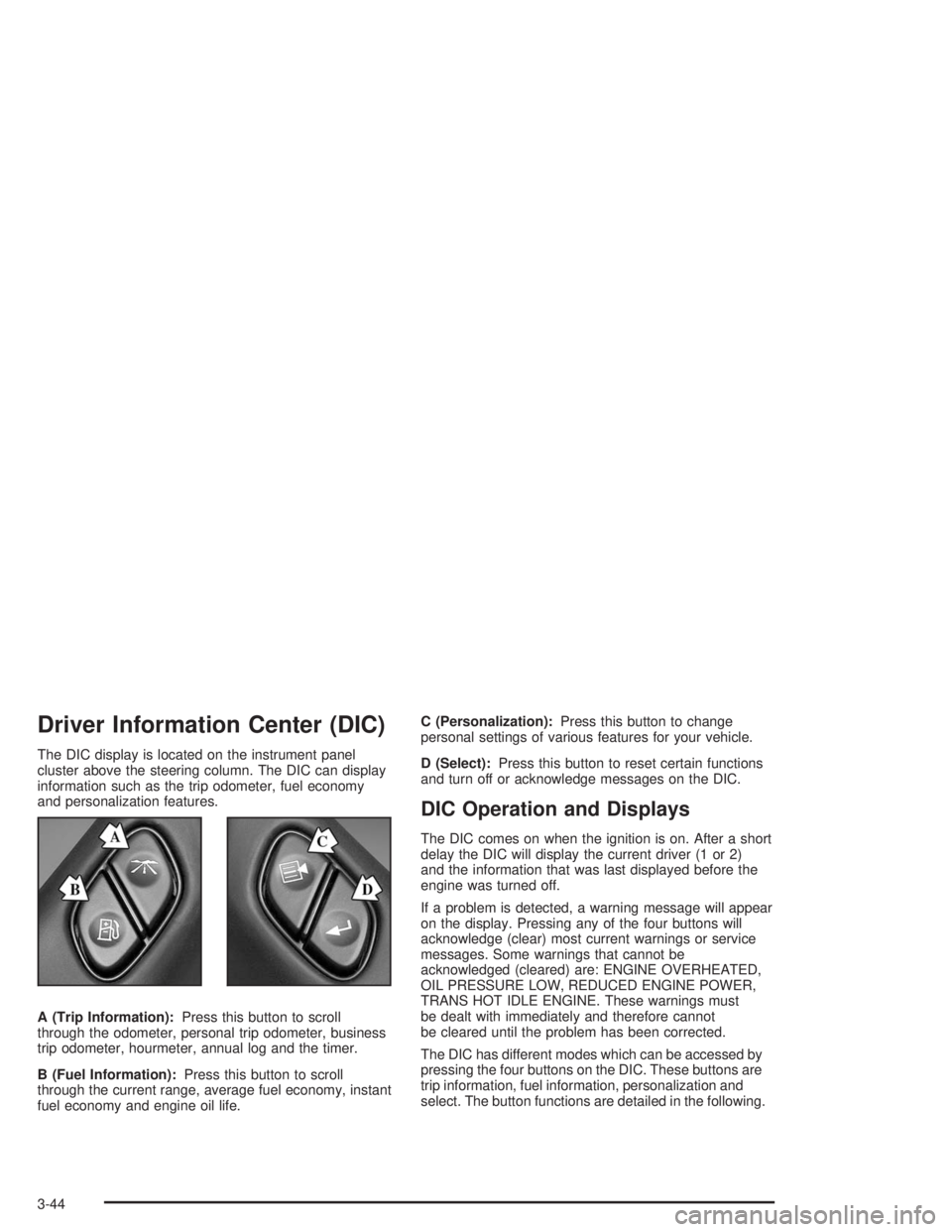
Driver Information Center (DIC)
The DIC display is located on the instrument panel
cluster above the steering column. The DIC can display
information such as the trip odometer, fuel economy
and personalization features.
A (Trip Information):Press this button to scroll
through the odometer, personal trip odometer, business
trip odometer, hourmeter, annual log and the timer.
B (Fuel Information):Press this button to scroll
through the current range, average fuel economy, instant
fuel economy and engine oil life.C (Personalization):Press this button to change
personal settings of various features for your vehicle.
D (Select):Press this button to reset certain functions
and turn off or acknowledge messages on the DIC.
DIC Operation and Displays
The DIC comes on when the ignition is on. After a short
delay the DIC will display the current driver (1 or 2)
and the information that was last displayed before the
engine was turned off.
If a problem is detected, a warning message will appear
on the display. Pressing any of the four buttons will
acknowledge (clear) most current warnings or service
messages. Some warnings that cannot be
acknowledged (cleared) are: ENGINE OVERHEATED,
OIL PRESSURE LOW, REDUCED ENGINE POWER,
TRANS HOT IDLE ENGINE. These warnings must
be dealt with immediately and therefore cannot
be cleared until the problem has been corrected.
The DIC has different modes which can be accessed by
pressing the four buttons on the DIC. These buttons are
trip information, fuel information, personalization and
select. The button functions are detailed in the following.
3-44
Page 189 of 472
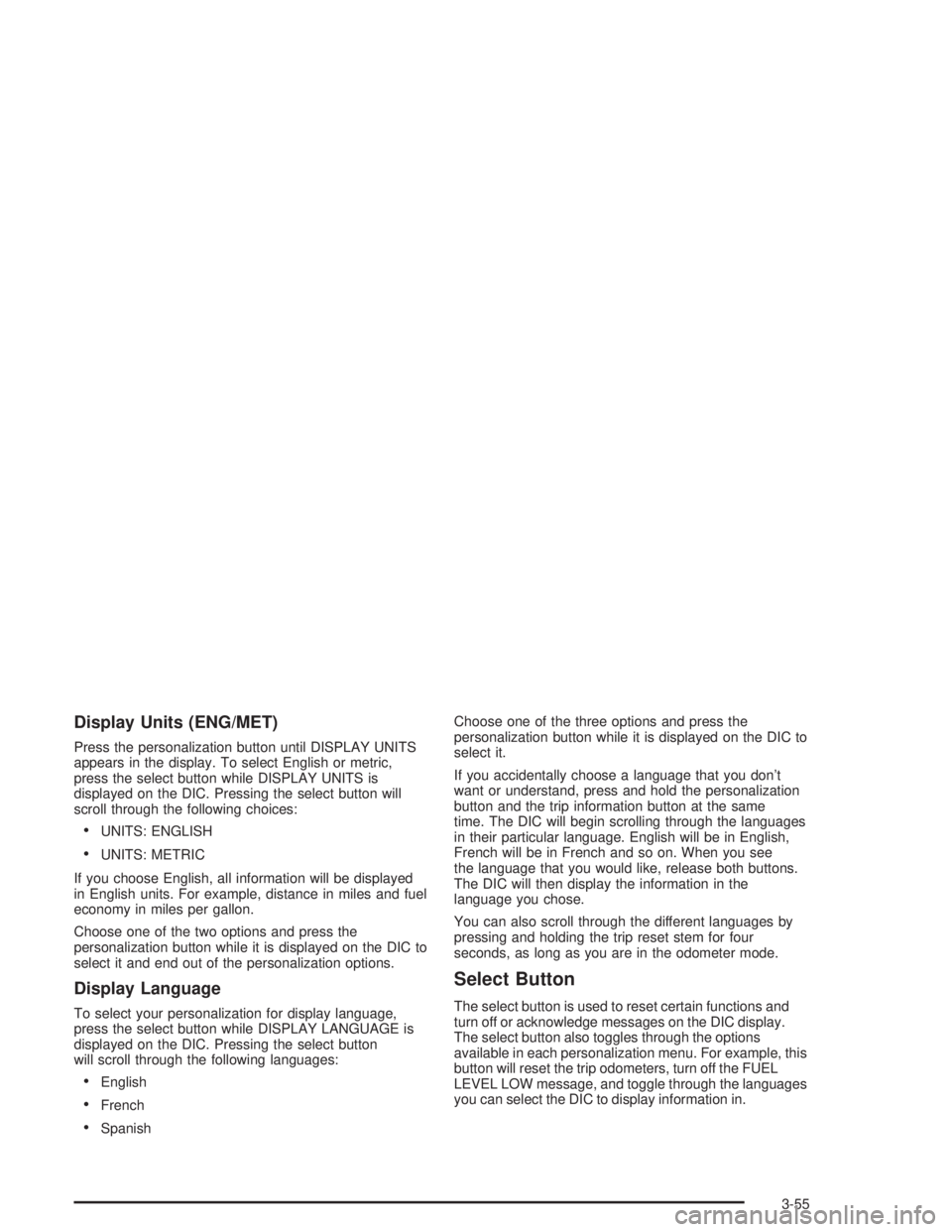
Display Units (ENG/MET)
Press the personalization button until DISPLAY UNITS
appears in the display. To select English or metric,
press the select button while DISPLAY UNITS is
displayed on the DIC. Pressing the select button will
scroll through the following choices:
UNITS: ENGLISH
UNITS: METRIC
If you choose English, all information will be displayed
in English units. For example, distance in miles and fuel
economy in miles per gallon.
Choose one of the two options and press the
personalization button while it is displayed on the DIC to
select it and end out of the personalization options.
Display Language
To select your personalization for display language,
press the select button while DISPLAY LANGUAGE is
displayed on the DIC. Pressing the select button
will scroll through the following languages:
English
French
SpanishChoose one of the three options and press the
personalization button while it is displayed on the DIC to
select it.
If you accidentally choose a language that you don’t
want or understand, press and hold the personalization
button and the trip information button at the same
time. The DIC will begin scrolling through the languages
in their particular language. English will be in English,
French will be in French and so on. When you see
the language that you would like, release both buttons.
The DIC will then display the information in the
language you chose.
You can also scroll through the different languages by
pressing and holding the trip reset stem for four
seconds, as long as you are in the odometer mode.
Select Button
The select button is used to reset certain functions and
turn off or acknowledge messages on the DIC display.
The select button also toggles through the options
available in each personalization menu. For example, this
button will reset the trip odometers, turn off the FUEL
LEVEL LOW message, and toggle through the languages
you can select the DIC to display information in.
3-55
Page 196 of 472
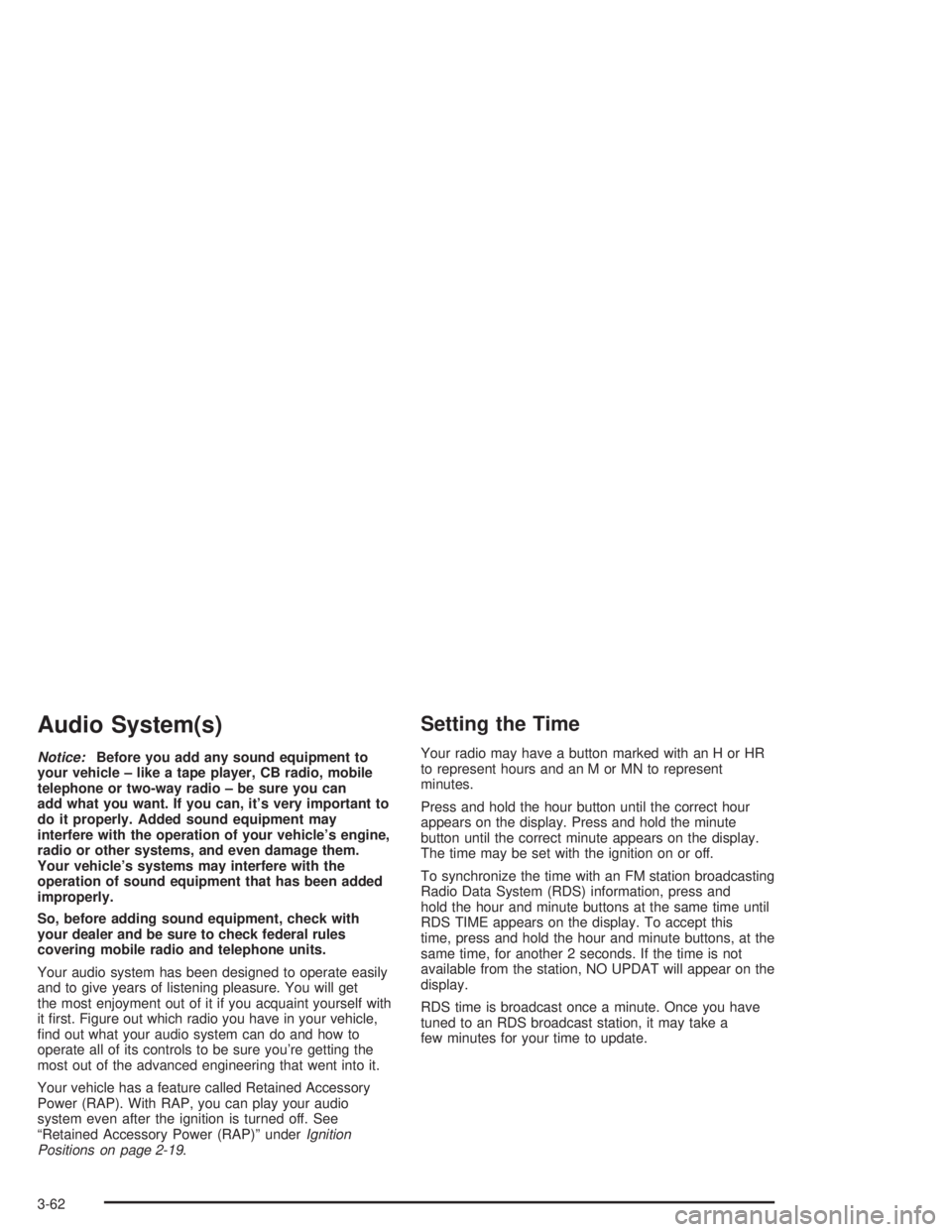
Audio System(s)
Notice:Before you add any sound equipment to
your vehicle – like a tape player, CB radio, mobile
telephone or two-way radio – be sure you can
add what you want. If you can, it’s very important to
do it properly. Added sound equipment may
interfere with the operation of your vehicle’s engine,
radio or other systems, and even damage them.
Your vehicle’s systems may interfere with the
operation of sound equipment that has been added
improperly.
So, before adding sound equipment, check with
your dealer and be sure to check federal rules
covering mobile radio and telephone units.
Your audio system has been designed to operate easily
and to give years of listening pleasure. You will get
the most enjoyment out of it if you acquaint yourself with
it �rst. Figure out which radio you have in your vehicle,
�nd out what your audio system can do and how to
operate all of its controls to be sure you’re getting the
most out of the advanced engineering that went into it.
Your vehicle has a feature called Retained Accessory
Power (RAP). With RAP, you can play your audio
system even after the ignition is turned off. See
“Retained Accessory Power (RAP)” underIgnition
Positions on page 2-19.
Setting the Time
Your radio may have a button marked with an H or HR
to represent hours and an M or MN to represent
minutes.
Press and hold the hour button until the correct hour
appears on the display. Press and hold the minute
button until the correct minute appears on the display.
The time may be set with the ignition on or off.
To synchronize the time with an FM station broadcasting
Radio Data System (RDS) information, press and
hold the hour and minute buttons at the same time until
RDS TIME appears on the display. To accept this
time, press and hold the hour and minute buttons, at the
same time, for another 2 seconds. If the time is not
available from the station, NO UPDAT will appear on the
display.
RDS time is broadcast once a minute. Once you have
tuned to an RDS broadcast station, it may take a
few minutes for your time to update.
3-62
Page 198 of 472
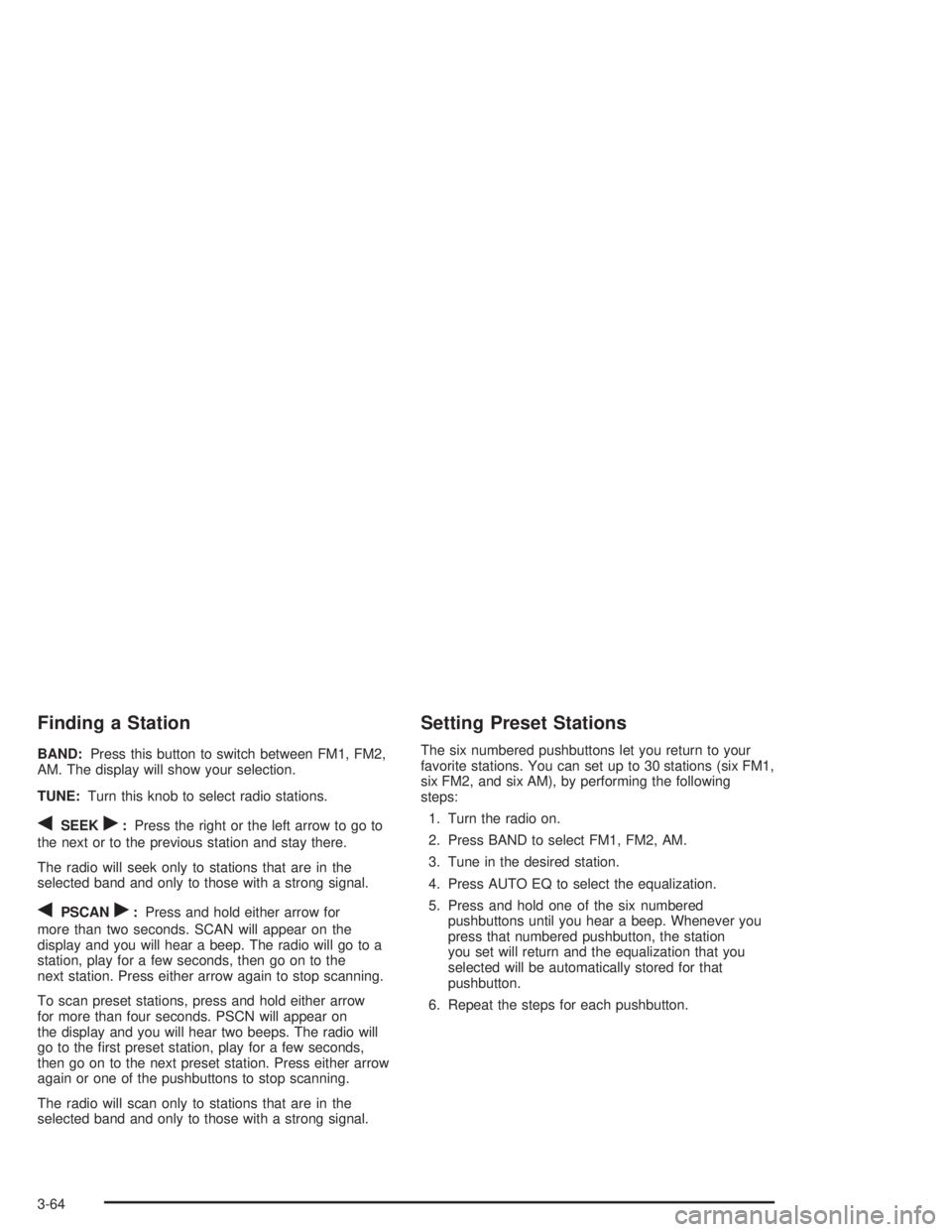
Finding a Station
BAND:Press this button to switch between FM1, FM2,
AM. The display will show your selection.
TUNE:Turn this knob to select radio stations.
qSEEKr:Press the right or the left arrow to go to
the next or to the previous station and stay there.
The radio will seek only to stations that are in the
selected band and only to those with a strong signal.
qPSCANr:Press and hold either arrow for
more than two seconds. SCAN will appear on the
display and you will hear a beep. The radio will go to a
station, play for a few seconds, then go on to the
next station. Press either arrow again to stop scanning.
To scan preset stations, press and hold either arrow
for more than four seconds. PSCN will appear on
the display and you will hear two beeps. The radio will
go to the �rst preset station, play for a few seconds,
then go on to the next preset station. Press either arrow
again or one of the pushbuttons to stop scanning.
The radio will scan only to stations that are in the
selected band and only to those with a strong signal.
Setting Preset Stations
The six numbered pushbuttons let you return to your
favorite stations. You can set up to 30 stations (six FM1,
six FM2, and six AM), by performing the following
steps:
1. Turn the radio on.
2. Press BAND to select FM1, FM2, AM.
3. Tune in the desired station.
4. Press AUTO EQ to select the equalization.
5. Press and hold one of the six numbered
pushbuttons until you hear a beep. Whenever you
press that numbered pushbutton, the station
you set will return and the equalization that you
selected will be automatically stored for that
pushbutton.
6. Repeat the steps for each pushbutton.
3-64